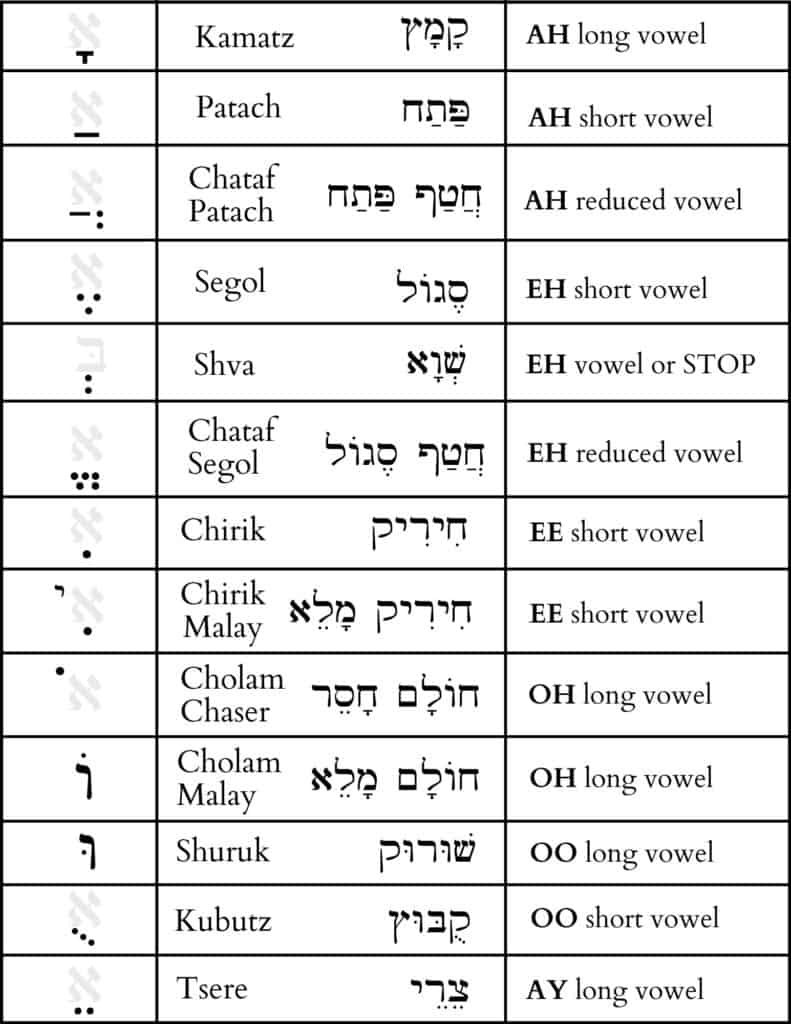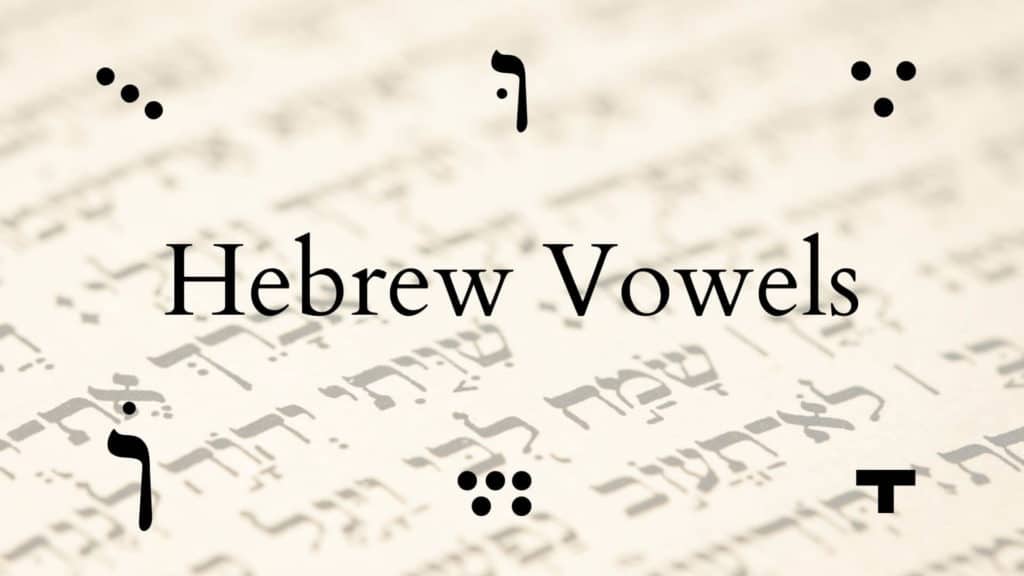Let’s Go In-Depth on Hebrew Vowels (Nikud) to Read Hebrew
Like most semitic languages, Hebrew originally did not have vowels. In fact, native speakers or those fluent in the Hebrew language don’t actually need vowels to read Hebrew. In the early Middle Ages, however, Jewish scribe-scholars known as the Masoretes came up with a system to standardize the pronunciation for those learning the language. They created a system of dots and dashes known in Hebrew as nikud which help teach us how to pronounce Hebrew words. There are 13 Hebrew vowels that will be discussed here on this Hebrew vowels chart.
In the Hebrew language, vowels are not A, E, I, O, and U like we have in English. Hebrew vowels are pronounced AH, EH, EE, OH, OOH, and AY. Most all of the vowels are symbols placed either directly underneath the letter, above the letter, or next to the letter. I have used the Hebrew letter ALEF as a placeholder to help indicate where the Hebrew vowel should be located.

There are three types of Hebrew vowels: long, short, and reduced. If you aren’t a native Hebrew speaker, the difference between the long, short, and reduced Hebrew vowel sounds are nearly impossible to hear. There is no audible distinction. For example, our ears can’t differentiate the difference in the AH sound in awesome vs. also or end vs excellent for the EH vowel. So, for anyone who isn’t a native speaker, the Hebrew vowels chart and explanation below is commonly how Hebrew vowel sounds are taught. There are other Hebrew vowel charts that will try and explain the sounds that are more typical of a Semitic language should you prefer. Otherwise, this way of teaching will make much more sense to you and is what is most commonly taught outside of Israel, but with it’s own B’nai Mitzvah Academy flair.
| AH: horizontal line | EH: 3+2=5 | EE (I): one dot |
| אָ | אֶ | אִ |
| אַ | בְּ | אִי |
| אֲ | אֱ |
| OH: over the letter | OO: my stomach hurts | AY: two horizontal dots |
| וֹ | וּ | אֵ |
| אֹ | אֻ |
AH VOWELS
There are three AH vowels in Hebrew. All three make a sound like the first syllable of the word “autumn.” All 3 AH vowels have a horizontal line as part of the vowel. None of the other vowels have horizontal lines; so, if you see one, you automatically assume that it is an AH vowel.
1. Kamatz AH Vowel
אָ
We refer to this as the “T” AH vowel because it looks like an uppercase T. Kamatz (קָמָץ) is a long vowel.
2. Patach AH Vowel
אַ
This AH vowel is simply a horizontal line. Patach (פַּתַח) is a short vowel.
3. Chataf Patach AH Vowel
אֲ
The third AH vowel is a horizontal line with two vertical dots to the right of the line. Chataf Patach (חֲטַף פַּתַח) is a reduced vowel.
EH VOWELS
There are also three EH vowels in Hebrew. All three make a sound like the EH in eggs. The EH vowel can be remembered with a simple math equation: 3 + 2 = 5. That’s because the three variations of the EH vowel have three dots, two dots and five dots.
1. Segol EH Vowel
אֶ
The first EH vowel is three dots in the shape of an upside down triangle. Segol (סֶגוֹל) is a short vowel.
2. Shva
בְּ
The second EH vowel is two vertical dots. This vowel, Shva (שְׁוָא) is more complicated.
If you see two vertical dots underneath the first letter of the Hebrew word, then the vowel is a vocal shva and makes an EH sound. There’s nothing more to it.
However, if you find the two vertical dots under any other letter in the word, these two vertical dots act as a silent shva or STOP SIGN. What do I mean by that? The two vertical dots underneath the letter stop the sound of the letter above. To proceed with reading the word, you then look to the next letter — to the left — to begin the next syllable and continue reading that word.
A vocal shva is considered a reduced vowel and a silent shva is technically not even considered to be a vowel at all.
P.S. You’ll noticed I used the Hebrew letter BET as a placeholder instead of ALEF because you can’t have a shva appear underneath a gutteral letter.
3. Chataf Segol
אֱ
The third EH vowel is five dots. Simply combine the other two EH vowels — three dots plus the two dots — and you have your final EH vowel. Chataf Segol (חֲטַף סֶגוֹל) is a reduced vowel.
EE VOWEL
1. Chirik EE Vowel
אִ
The EE vowel is simple. Just place one single dot centered underneath a Hebrew letter. Chirik (חִירִיק) is a short vowel.
2. Chirik Malay EE Vowel
אִי
If the letter YUD doesn’t have a vowel under or next to it, then it becomes part of the EE vowel. Think of it this way – yud makes a “y” sounds like yogurt, so if you tack on a “y” sound to an “ee” sound, the two sounds would be exactly the same. ee=eey
OH VOWELS
1. Cholam Chaser OH Vowel
אֹ
The OH vowel is a dot that is OHver the letter above the upper left corner. Cholam Chaser is a long vowel.
2. Cholam Malay OH Vowel
וֹ
This OH vowel is a dot directly over what looks like the letter VAV, but the VAV in this case is not pronounced. Let me repeat because this is a tricky concept. If there is a dot over the letter VAV, it no longer makes a “v” sound like the letter VAV does. This particular vowel, Cholam (חוֹלָם) is always directly next to the letter it is associated with. Cholam is a long vowel.
OO (U) VOWELS
1. Kubutz OO vowel
אֻ
This OO vowel has three diagonal dots underneath a letter. There is nothing tricky about this particular OO vowel except that you see it so few times in the siddur that you might forget it! Kubutz (קֻבּוּץ) is a short vowel.
2. Shuruk OO vowel
וּ
The Shuruk OO vowel is a dot in the middle of what looks like the letter VAV. How do you remember that the OO is in the middle? Your stomach is in the middle of your body and if you have a stomach ache, you would moan and groan and say “OO my stomach hurts.” Just like with the OH vowel above, if there’s a dot in the middle of a VAV, the VAV is not pronounced. This OO vowel will also be located directly next to the letter it is associated with. Shuruk (שׁוּרוּק) is a long vowel.
AY VOWEL
1. Tsere AY Vowel
אֵ
Our final vowel is the AY vowel. The AY vowel is two dots next to each other horizontally. Tsere (צֵרֵי) is a long vowel. Israelis will often phonetically spell this vowel sound as EH like the vowel sound “e” in the word they, but that makes it difficult for non-native speakers to differentiate between this vowel and the other three EH vowels.
You’ll also sometimes find a YUD letter without a vowel attached to the end of the syllable just like we saw with the EE vowel. This would be a Tsere Malay which makes the same sound. AY= AYY. Therefore, the YUD without a vowel underneath becomes part of the AY vowel.
There is another vowel that I did not include on the chart, Chataf Kamatz (אֳ) which is quite rare. While you might think that this vowel makes an AH sound based on its name, the vowel actual makes an OH sound.
Click here for a printable version of the Hebrew Vowel Chart

Was this Hebrew vowels chart helpful? Do you want to continue your Hebrew training? If so, you can do so for free with B’nai Mitzvah Academy’s ten lessons to learn to read Hebrew. You can also purchase helpful training tools like this Hebrew workbook to maximize your progress! Don’t forget to read more content on the BMA blog.
Handwritten Hebrew Alphabet: Learn Hebrew Cursive and Print
Free Hebrew Fonts: Typing Hebrew in Google Docs
You MUST Use Hebrew Flashcards to Learn the Alphabet


This was a great introduction to Hebrew vowels! Thank you. I am an English speaker currently studying Hebrew and I frequently find myself a bit lost. 🙁
Very helpful, especially the chart. I am reading Tefillim and the Talmud in Hebrew and English and periodic reassurance that I am pronouncing and enunciating correctly.
For the overwhelmingly vast majority of Hebrew scholars, experts, and students (this includes the residents of Israel) the actual correct ancient mystical prophetic pronunciation of Hebrew is still a near complete mystery!
I was always confused with Hebrew Vowels but now I am able to work through them. This is really helpful and I am very much thankful.
Did the original Hebrew language of the biblical period have vowels? I have heard that it did not but wanted to ask.
Excellent explanation. It helped me a lot.